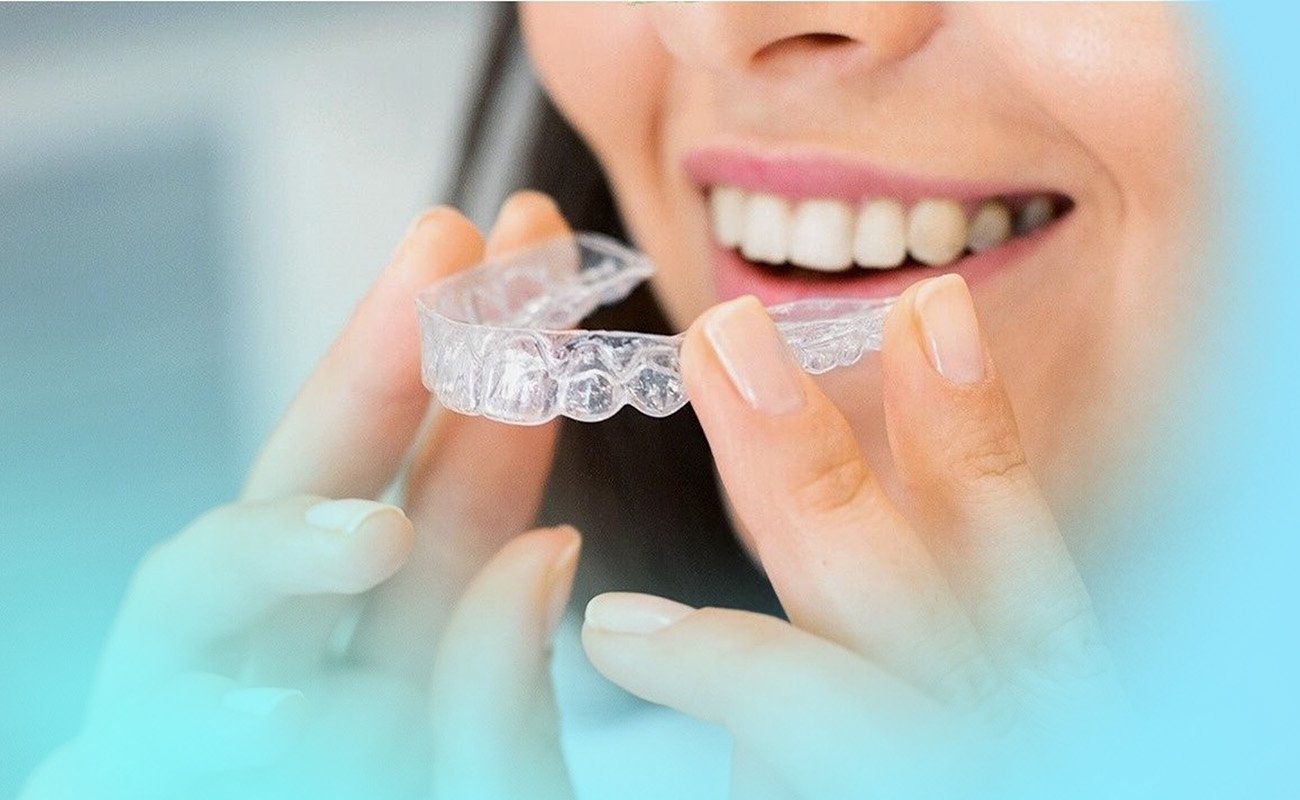Invisible braces, also known as clear aligners, have become an increasingly popular alternative to traditional metal braces for those seeking straighter teeth. As the name suggests, these orthodontic devices use a series of customized, transparent plastic trays to incrementally shift teeth into place over time.
This article will unpack the basics of how invisible braces work, providing a straightforward overview of their design, functionality, and the process involved in straightening teeth with this modern orthodontic solution.
What are Invisible Braces?
Invisible braces are a relatively new type of orthodontic treatment. They are different from traditional braces in that they use customized clear plastic aligners to gently and gradually shift your teeth in the desired position. As the aligner plate rests over individual teeth and applies controlled pressure, it causes your teeth to slowly move.
Wearing aligners eliminates many of the daily maintenance tasks associated with standard braces such as checking for broken brackets or wires and tightening. Furthermore, they are virtually undetectable to others and can be removed at any time such as during meals, for photographs, or when brushing and flossing, which makes them a great option for adults who want to straighten their teeth more discreetly.
See our article: How to Fix a Smile Without Braces?
How Do Invisible Braces Work?
Invisible braces work through a sequence of clear aligners that are custom-made to fit the shape of an individual’s teeth closely. This precise fit allows each aligner to apply the necessary amount of pressure to gradually move the teeth into the desired position. The pressure is controlled and applied in small increments, facilitating a gradual and predictable adjustment of the teeth over time.
Patients are provided with several sets of aligners and are usually instructed to switch to a new set every two weeks. This ensures a continuous and gradual movement of the teeth. For the treatment to be effective, the aligners must be worn for at least 22 hours a day; otherwise, the intended movement of the teeth may not occur as planned.
Good oral hygiene is essential during the treatment with invisible braces. Patients should brush and floss regularly to prevent tooth decay. Additionally, aligners should be removed when eating or drinking anything other than water to prevent damage to the aligners and to ensure the treatment proceeds as expected.
Who Can Wear Clear Aligners?
Clear aligners can be worn by anyone looking to achieve straighter teeth. Aligners appeal to teens and adults as they offer a discrete and relatively comfortable way to move teeth into proper alignment without the hassle associated with metal braces. Additionally, overall affordability for aligners makes them especially appealing to adult patients who may be on a limited budget.
Moreover, aligners are ideal for treating minor crowding or spacing issues, as well as mild overbites, underbites, and crossbites. They are also a great option for those who want to align their teeth without the use of metal braces.
See our article: Is 40 too old for braces?
How Long Does it Take to Straighten Teeth? Are Clear Aligners a Faster Solution?
When it comes to straightening teeth, the amount of time required will vary depending on the severity of the issue and the chosen treatment route. The length of time is also relevant to a patient’s unique mouth structure, as well as what type of treatment they are pursuing.
Traditional braces typically take anywhere from 18 months to three years for full correction, though treatment may be shorter or longer depending on the severity of the malocclusion. For clear aligners, treatment can take anywhere between 6-18 months. However, the effectiveness and duration of clear aligner treatment heavily relies on the patient’s commitment to wearing the aligners as instructed. To achieve optimal results, patients need to wear the aligners consistently for approximately 22 hours per day. Failure to adhere to this recommendation may prolong the treatment timeline.

Worth Knowing
According to the article published in The Angle Orthodontist, aligner therapy requires significantly fewer visits to an orthodontist and a shorter treatment time than braces.
The Difference Between Clear Aligners and Other Types of Braces
Made from plastic
Clear aligners are very different from metal braces in that they employ custom-made, clear trays made from dental-grade thermoplastic material. These trays are designed to fit tightly on the teeth, providing a less visible and more comfortable type of orthodontic treatment. Each aligner is tailored to the unique shape of the patient’s teeth, moving them gradually to the correct position without using metal brackets and wires.
Discreet
Unlike traditional metal braces, clear aligners do not use brackets or wires, but instead, consist of transparent, custom-fitted trays that cover the teeth. This transparency allows them to blend seamlessly with the natural color of the teeth, rendering them almost undetectable to the casual observer.
No diet restrictions
One of the practical benefits of clear aligners compared to other types of braces is the lack of dietary restrictions. Clear aligners are removable, allowing patients to eat and drink without worrying about damaging or staining their orthodontic device. This freedom means individuals undergoing treatment can enjoy a wide variety of foods and beverages, including crunchy snacks, hearty meals, and colorful drinks.
Easy to maintain
Clear aligners offer a hassle-free experience with their easy maintenance and minimal dental check-ups, setting them apart from traditional options like metal, clear, and Incognito/lingual braces. Their design allows for easy removal, enabling patients to clean both their teeth and aligners effortlessly, streamlining oral care. This convenience extends to fewer orthodontist visits for adjustments, making clear aligners a perfect fit for those with busy lifestyles.
See our article: Quickest Way to Straighten Teeth.
Comfortable
Metal braces use metal bands that are affixed around each tooth using brackets and wires to move teeth into position, they can sometimes cause discomfort due to sharp edges left by components like springs. Unlike traditional braces, aligners cause minimal discomfort and don’t have any metal wires or brackets that can irritate the mouth and gums.
Do Invisible Braces Work?
Invisible braces are an effective solution to teeth straightening issues as long as the patient adheres to the guidelines of wearing them set by their orthodontist. Studies show that these invisible braces are effective at correcting misaligned smiles and significantly improve self-confidence among users.
For this reason, it’s easy to see why invisible braces have become such a popular option for people looking to improve their smiles without traditional metal or ceramic devices.
If you are looking for an affordable and efficient teeth straightening solution then invisible braces are a great choice. It is possible to order clear aligners online but it is recommended that you only do so through registered and trustworthy companies. Here is a selection of companies to help you with your selection.

Byte
An affordable option with refundable impression kits, free HyperByte, and a Byte for Life guarantee.
Check out Byte Aligners
AlignerCo
The cheapest at-home aligners, with monthly plans, no down payment, and considerable discounts.
Check out AlignerCo Aligners
Candid
A hybrid of in-office and at-home treatment that provides 1-on-1 orthodontist support.
Check out Candid AlignersReferences
Buschang, P.H., Shaw S.G., Ross M., Crosby D., Campbell P.M., Comparative time efficiency of aligner therapy and conventional edgewise braces. Angle Orthod (2014). DOI: 10.2319/062113-466. Available online at: https://meridian.allenpress.com/angle-orthodontist/article/84/3/391/58505/
Ke, Y., A comparison of treatment effectiveness between clear aligner and fixed appliance therapies. BMC Oral Health. 2019. doi: 10.1186/s12903-018-0695-z Available online at: https://www.ncbi.nlm.nih.gov/pmc/articles/PMC6343314/
Mortazavi, M., et al. An updated systematic review on the effectivity of clear aligner therapy: A review. Journal of Craniomaxillofacial Research. (2020). Available online at: https://www.researchgate.net/publication/349579223_An_updated_systematic_review_on_the_effectivity_of_clear_aligner_therapy

